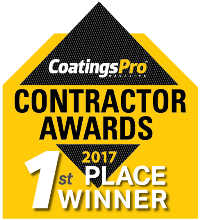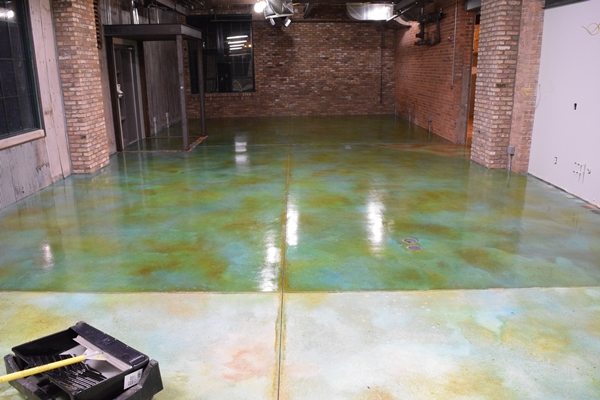Long considered industrial and outdated, the downtown of Detroit, Michigan, is in the midst of an urban revival. Significant residential and retail developments, new sports arenas, and even a streetcar line for public transit have all opened in recent years.
One complex in Detroit’s Rivertown warehouse district was once an electric transformer factory, owned by Dongan Electric. The two-story building was vacant for years until a private investment group headed by specialty food group Collaborative Advantage Marketing (CAM) purchased it in 2015. CAM, formerly located in suburbia, planned to become one of the new tenants while renting out the remainder of the space.
The group wanted to renovate the building for modern use while still retaining a feel of “vintage industrialism” as a nod to Detroit’s history. Local flooring contractor Premier Veneers, headed by owner Jeff Donius, was tapped to develop an acid-stained decorative look for CAM’s main office and some adjoining areas.
“My company was hired to do both the new and old concrete finish work, including repairs,” Donius said, explaining that part of the work involved a new concrete pour, while another dealt with the renovation of existing concrete.
“The project was behind schedule, due to delays with other trades. And since my work was last, all of the pressure was placed on me to finish as soon as possible,” Donius explained. “The owner said they were losing thousands of dollars per day because they were paying for two locations at once, and I didn’t want to be the reason they continued to lose money.”
One-Man Assembly Line
The client anticipated having the project completed by Christmas so that they could move in at the start of January. But the delays were such that Donius couldn’t even start his portion of work until after Christmas — and even then, he was still working around other trades!
Complicating matters more, Donius needed to work alone to ensure quality. “A lot of larger crews have three or four people, but if they’re each doing part of a decorative application, they all have their own technique and pattern tendencies,” he said. “So when you look at the final project, you’ll see variations from one area to the next. There are a lot of staining contractors like me that work either by themselves or just with a helper so they can maintain the decorative look consistently across the entire floor.”
Donius presented several acid-stained sample boards to the client beforehand for feedback, all to ensure the look would be just right.
Safety First
Wearing safety goggles, a full-face piece air purifying respirator from Honeywell, and 3M’s disposable dust masks, Donius  quickly got to work in late December. He also used custom knee pads and anti-vibration work gloves when grinding, with a dust shroud and high-efficiency particulate air (HEPA)-filter concrete dust collector during diamond cup grinding and cement overlay sanding.
quickly got to work in late December. He also used custom knee pads and anti-vibration work gloves when grinding, with a dust shroud and high-efficiency particulate air (HEPA)-filter concrete dust collector during diamond cup grinding and cement overlay sanding.
While Donius also had to deal with a 250-square-foot (23.2 m2) adjoining area comprised of old and damaged concrete, a large part of his work involved 2,200 square feet (204.4 m2) of new concrete for CAM’s main office area. Using a Mongoose decorative concrete engraving saw from Engrave-A-Crete with a .125-inch (0.32 cm) diamond blade, Donius made saw-cut transitions between the main area’s acid-stained floor and a cement overlay from the other room.
Surface preparation was first on the main room’s agenda. Donius cleaned the floor with a Bissell BGLB9000 machine with a black stripping pad and biodegradable detergent, then vacuumed it up with a wet/dry vacuum from Craftsman. Paint, primer, drywall mud, mortar, and other construction materials that didn’t come up with the pad were scraped up with a wallpaper removal tool or spot removed via rag with a solvent. A special Prosoco cleaner was needed to remove tar, which had accumulated in spots due to ceiling work by other trades.
Decorating the Office
With the surface prepared, it was finally time to decorate! Using 2.5-gal. (9.5 L) pump-up sprayers, Donius applied two coats of Artcrete Aquamarine’s acid stain in a blue color at a rate of 375 square feet/gal. (9.2 m2/L). The coats were applied 24 hours apart, and residue was rinsed after the first coating. Then, Donius used handheld water misters to spray three light applications of a QC Patina Stain product from QC Construction Products in a reddish-brown color, as well as three light applications of the Perma-Cast Sierra Stain from Butterfield Color in medium brown. These products were chosen for highlighting and accenting purposes.

“One thing that happens with acid staining, and it’s why I prefer it over metallic epoxy coatings even though there aren’t four layers of thicknesses of stain, once you add that clear sealer, it adds luster and depth to the floor so that you see all those different colors and depths. It makes it look like it’s not just a coating of color, but like it’s actually marble or stone.”
He then rinsed away residue and neutralized the pH of the concrete by using a solution of 12 parts water and one part ammonia. The Craftsman vacuum was used to dry the surface.
At this point, Donius encountered an unexpected problem. Using a Tramex electronic moisture meter before applying the seal coats, he discovered the floor was drying extremely slowly because the building’s heat was not running yet, and temperatures were below freezing in the brutal Detroit winter.
Working with the owner and project manager, Donius set up a plan to bring in propane heaters, blowers, and an industrial dehumidifier. Within two days, the heat rose to near 80 °F (26.7 °C), and moisture content readings dropped from over 6 percent after the initial drying to less than 5 percent, the threshold for applying the seal coat.
His coating of choice was the clear Polyurea-1 HD from Citadel, described by the manufacturer as a single-component, ultraviolet (UV) stable, aliphatic polyurea with superior chemical resistance. “Polyureas are just much more durable than epoxies, with more longevity and less maintenance because they’re harder and more scratch resistant,” Donius explained.
The Polyurea-1 HD was applied in two coats of ~3 mils (76.2 microns) dry film thickness (DFT) each, using an 18-inch (45.7 cm) roller with a 0.25-inch (0.64 cm) nap. Both coats had a 240-grit aluminum oxide mixed in at a rate of 8 oz./gal. (59.9 g/L) for added slip resistance. “Polyureas are so dense and so hard that they are extremely slippery when wet with no non-slip aggregate added,” Donius said.
In addition, each polyurea coat cured as quickly as five hours, Donius recalled. Because of that, by the time he finished applying the first coat, it had cured and was hard enough to start on the second coat. “On this project, the owner thought every hour was important,” he said.
Open for Business
Though it required daily 18-hour shifts, Donius was able to complete the entire job in just 13 days, allowing the revived building to begin operations in January.
“It took 18-hour days to work around the other trades, including nights, weekends, Christmas Eve, and New Year’s Eve,” Donius recalled. “And most of the time it was with limited lighting and heat. But I was able to do so in a constructive manner with the owner and project manager, and I finished the decorative work in under two weeks.”
Due in large part to his hard work, the building is currently home for CAM as well as jeans manufacturer Detroit Denim, a new art gallery, luxury residential lofts, and more.
“They were very happy,” Donius said of the client. “The woman I most often worked with called it a world-class floor. I’ve had nothing but praise and good comments.”
For this coatings client, it could be considered a New Year’s gift!
Editor’s Note: For his hard work, Donius won first place in the Commercial Concrete category in CoatingsPro’s 2017 Contractor Awards Program! Enter your project for a chance to win this year's program here. And to read part 2 of this article, head here.
